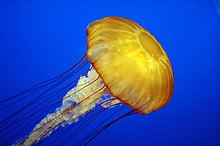
Back Амыжьҳаҭ Abkhazian Kwalle Afrikaans قنديل بحر Arabic Meduza Azerbaijani دنیزآناسی AZB Медузы Byelorussian Медузи Bulgarian जेलीफिश Bihari জেলিফিশ Bengali/Bangla Bloneg-mor Breton
| Jellyfish | |
|---|---|

| |
| Pacific sea nettle (Chrysaora fuscescens) | |
| Scientific classification | |
| Domain: | Eukaryota |
| Kingdom: | Animalia |
| Phylum: | Cnidaria |
| Subphylum: | Medusozoa |
| Groups included | |
| Cladistically included but traditionally excluded taxa | |

Jellyfish are animals of the phylum Cnidaria. They are a monophyletic clade, the Medusozoa.[1] Most of them live in the oceans, in salt water, where they eat small sea animals like plankton and little fish, and float in the sea. Only a few jellyfish live in fresh water.
They have soft bodies and long, stinging, venomous tentacles that they use to catch their prey, usually small plankton animals or small crustaceans or tiny fish. Some jellyfish hunt others by stinging cells called nematocysts. A jellyfish is 97% water.[2][3]
Most jellyfish have a bell-shaped body and long tentacles at the underside of the body. Tentacles are long "arms" with special stinging cells called cnidoblasts containing the structure of the nematocyst inside. The nematocysts are pockets in the tentacle that have a small stinger that is sealed with a cap. There is a microscopic hair, or “trigger” on the outside of the pockets and when the tentacle brushes against something it activates the hair which opens the cap and allows salt water to pour in. The inrushing salt water increases the pressure in the nematocyst pushing out the venomous tentacle or thread, thus stinging the jellyfish’s prey.[4] They move by contracting their bodies, but they do not have much control over where they go: most of the time, they drift with the water current. The largest type of jellyfish is the Lion's mane jellyfish, which has tentacles that can be as long as 60 meters, but most jellyfish are much smaller.
The Medusozoa are four classes of the Cnidaria: [5]
- Scyphozoa: the true jellyfish
- Cubozoa: the box jellyfish
- Staurozoan: the stalked jellyfish
- Hydrozoa: the hydroids
There are many types of jellyfish. The smallest jellyfish are just a few centimetres across. The largest jellyfish is the Lion's mane (Cyanea capillata), whose body can be over 3 feet (1 m) across, with much longer tentacles. Some jellyfish glow in the dark (this is called phosphorescence). Some of the most dangerous jelly fish include the box jelly (Genuses Chironex, Chiropsalmus and Carybdea) and the tiny, two-cm-across Irukandji jelly (Carukia barnesi); the venomous sting of these jellyfish can kill a person.
Many animals eat jellyfish, including sea turtles and some fish (including the sun fish). Humans eat jellyfish too; especially in Asia jellyfish are a delicacy. Jellyfish spoil very quickly after they are caught. Sometimes they are dried to preserve them. Or, they are cleaned, which can take up to 40 days. They are often eaten in a kind of salad, with soy sauce or vinegar.
- ↑ Daly M. et al 2007. The phylum Cnidaria: a review of phylogenetic patterns and diversity 300 years after Linnaeus. Zootaxa, 1668: 127–182, Wellington. Abstract - PDF
- ↑ "Jellyfish, Enchanted Learning Software". enchantedlearning.com. Retrieved 7 April 2010.
- ↑ "Israeli boy, 9, dies in Thailand after jellyfish sting". The Times of Israel. Retrieved 31 August 2021.
- ↑ Olivia (2019-03-27). "All about jellyfish stings". Curious. Retrieved 2022-03-14.
- ↑ Classes in Medusozoa based on "The Taxonomicon - Taxon: Subphylum Medusozoa". Universal Taxonomic Services. Archived from the original on 2009-03-11. Retrieved 2009-01-26.